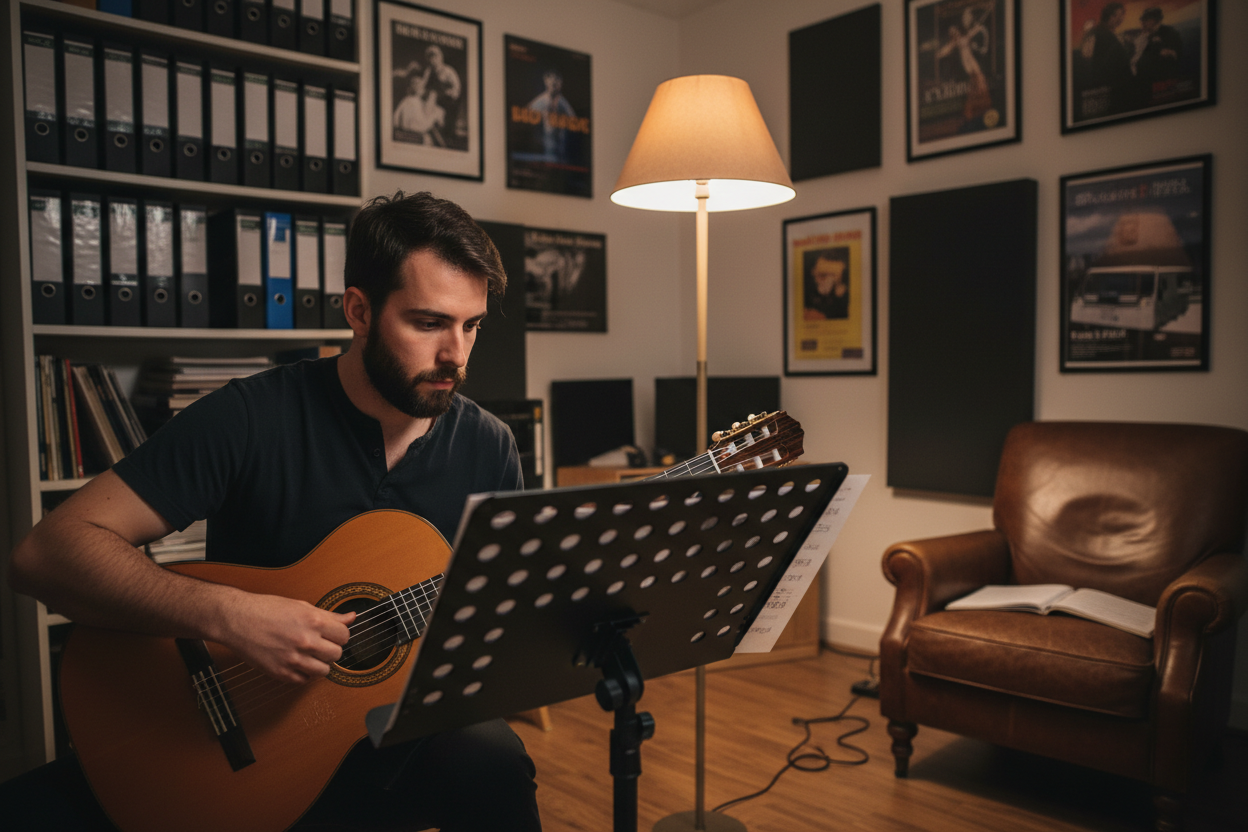Affiliate Disclosure: This article contains affiliate links. If you click on these links and make a purchase, we may earn a commission at no extra cost to you. We only recommend products or services we believe will bring value to our readers.
Learning guitar chords can be a frustrating process. Even if you possess a musical ear, working out the finger placement and hand posture for complex chords and changing from one to another can be difficult. If you are just getting started, here are some tips on practicing guitar chords and getting better at playing music.
Keep your fretting hand nails trimmed
Maintaining well-trimmed nails on your fretting hand is an important aspect of guitar playing. While it may seem obvious, it's easy to overlook. Long nails can impede your finger placement and negatively impact your playing technique. Regularly keeping your nails short will ensure optimal performance on the guitar.
What guitar chords should I learn first?
There is no single answer to this question as everyone may have different preferences. However, some guitarists may first recommend learning the basic open chords such as E, A, D, G, C, and F. These chords are commonly used in many popular songs and are considered essential for beginners. That said, it ultimately depends on what type of music you want to play and your goals.
How do I improve my hand posture when forming guitar chords?
When it comes to improving your hand posture when forming guitar chords, there are a few key things to keep in mind.
You want to make sure that you are using the correct amount of pressure when pressing down on the strings. Too much pressure can make it difficult to form the chord correctly, and too little pressure can cause the chord to sound muted.
When forming a guitar chord, your notes will ring out best when your fingers are placed behind the frets, although you can still get the notes to ring well if your finger is at the mid-point between two frets. Knowing this can help you avoid over-stretching your hands when it is not necessary.
But once you start moving your finger from the mid-point between 2 frets towards the lower fret (in the direction of the guitar's headstock), you will start to get some unwanted fret buzz.
Fitting your fingers between the strings without muting the notes of the chord
Many novice players will have muffled-sounding chords. Part of the problem could be their fingers touching adjacent strings and muting the chord's notes.
Sometimes this happens because your finger is leaning into the string next to it. You'll need to adjust your hand posture, so your finger clears the string that needs to ring.
What if my fingers are big and cannot fit between the strings?
Fortunately, some techniques can help those with big fingers play guitar chords. I've seen players with huge hands play chords no problem, and with practice, you can too.
The following techniques can help anyone no matter what size their hand is as well. Let's take a C chord for our example. New players will often mute the high E string, G string, and the D string when first encountering this chord.
How can this be avoided? Let's start with the C note on string 5 at the 3rd fret.
Since string 6 is not used in our C chord, we can position finger 3 so that it clears string 4 by touching string 6. Consequently, this will help us make our chord sound good by keeping string 6 muted in case we accidentally strum it. So when learning chords, feel free to touch adjacent strings that should be muted to keep your fingers clear of the strings that need to ring.


Since our C chord's E note on string 4 is on a lower fret than our C note on string 5, we can safely fret the E note while touching string 5 with finger 2 without muting our C note. This gives us the space we need to keep clear of the G string.
Let's move on to the following trouble note. To avoid muting the high E string when playing a C chord, make sure you position finger 1 as close to the G string as possible. Your fingernail can get very close to the G string and give you the space needed to clear the E string. But you have to make sure your 1st finger is not leaning into the E string, so work on your hand posture until you clear both strings.

It should be noted that it will be more difficult to play chords if you have not developed calloused fingertips yet. One reason is you have to press harder, causing your soft fleshy fingertips to spread out and occupy more space on the fretboard. However, you can develop your callouses with simple chromatic scale exercises.
When your fingertips become hardened, they can pinpoint the notes you want to fret, and you won't have to press as hard to get the notes to ring out. It just all gets easier when your fingertips have been conditioned.
Why do my chords sound pitchy or out of tune?
So your chords are ringing nicely, but they sound slightly off. First, you must determine that your guitar is intonated and set up correctly. If you are unfamiliar with guitar setup, have your local guitar tech check your intonation for you. If your guitar's intonation is off, everything you play will sound a little out of key.
If your guitar's intonation is good, then 3 things can cause your chords to sound pitchy.
1. You are pressing too hard. Pressing too hard can raise the pitch of your fretted notes, especially if you have tall frets. Only press hard enough for the note to ring clearly. This is not only a problem with a novice, but I've witnessed acoustic guitar players trying the electric guitar for the first time and had this issue. The acoustic guitar takes more force to squeeze out the notes; you need to lighten up your grip when playing an electric guitar.
2. You are bending your strings. When learning chords, students tend to pull down or push up on their strings while they are trying to fret the notes. This not only gets you too close to adjacent strings but will raise the pitch of the fretted notes and cause your chords to sound a bit off.
3. Your action is too high. If your guitar has high action, it can throw off the intonation as it takes more force to fret the note, and the added tension can raise the pitch causing your chord to sound off.
Should my thumb be behind the guitar neck or wrapped around it when playing guitar chords?
This is a common question with no true right or wrong answer. Most beginners will play guitar chords with their thumb behind the neck, but this might not be the most comfortable or efficient position for you. Experiment with both and see which is easier for you to use. I use both techniques depending on the scales or chords I'm playing.
How often should I practice guitar?
The amount of practice required to improve on guitar depends on factors such as the individual's natural talents, starting skill level, and how much time they are willing to dedicate to practice.
However, it is generally agreed that regular practice is essential to becoming a competent guitar player. A good rule of thumb is to practice for at least 30 minutes a day, 5 days a week. Break it into three 10-minute sessions per day when you are first starting out. This will keep things fresh and help you avoid overuse injuries and sore fingertips.
Practice two chords at a time, i.e., Chord Snapping
Once you have figured out the hand posture needed to practice your chords, take 2 chords and start switching back and forth between them. This is referred to as chord snapping or chord flipping.
Start by picking each note, making sure that every string rings clearly. When you go back and forth between chords, it will develop your muscle memory. This exercise should be done slowly and accurately.
Once you have become more confident with the chords and are at the point where you have them memorized, then start strumming the chords along with a metronome.
This ensures that you develop good timing as you do your chord snapping. Set the metronome at a slow tempo, 50 or 60 bpm, and see if you can keep up with snapping the chords without making mistakes. If you need more time to form your chord shapes, skip a beat or 2, but try to land your chord in sync with the metronome.
Once you have mastered a tempo and can accurately play the exercise 3x in a row, increase the metronome's tempo by 5 beats. Our goal is to be able to switch between chords quickly. You will keep increasing the tempo of your metronome as you progress and soon you will be able to change chords quick enough to play most songs.
Learn chord progressions and simple 3 and 4 chord songs
Now that you have learned a few chords try learning some simple songs and chord progressions. Some common chord progressions are I-IV-V, ii-V-I, I-vi-IV-V, ii vi V I. If you are unfamiliar with chord families, you'll want to ensure you include them in your studies. But to give you a quick example in the key of C, here are the chords and their numbered references.
I ii iii IV V vi vii
C Dm Em F G Am B diminished
Assigning numbers to chords is a great way to understand the relationships between chords and chord families. In music theory, chords are often referred to using Roman numerals, with uppercase numerals representing major chords and lowercase numerals representing minor chords. For example, the I chord is the tonic (or root) chord, and is typically a major chord. The ii chord is the supertonic chord, which is typically a minor chord, the iii chord is the mediant, typically minor, and so on.
One of the most common chord progressions in music is the 1-4-5 progression. This progression, also known as the "three-chord trick" is based on the I, IV and V chords, which are the tonic, subdominant and dominant chords, respectively. For example, in the key of C major, the 1-4-5 progression would be C - F - G, which are the chords of C major, F major and G major.
Another example is the ii-V-I progression, which is a very common chord progression in jazz music. This progression is based on the ii, V and I chords, and in the key of C major would be Dm - G - C. This progression creates a sense of resolution as the progression starts with ii (minor) chord and ends on the I chord (major).
By understanding how to relate these formulas to their chords, a guitarist can quickly and easily create new chord progressions and apply them to different songs. They can also start to recognize these progressions in other songs and use them in their own playing, making it easier to improvise and write new music.
Overall, learning the basic concepts of the number system and how they relate to chords and chord families can be a powerful tool for any guitarist, helping them to better understand the underlying structure of the music they are playing and use that knowledge to create new and exciting sounds.
The Circle of Fifths Chord Exercises
The circle of fifths is a fundamental concept in music theory that can be extremely useful for guitarists looking to expand their chord vocabulary and improve their improvisation skills. The circle of fifths is a representation of all the key signatures in Western music, arranged in a circular pattern based on their relationship to one another. Each key signature is represented by a Roman numeral and is one fifth (or seven semitones) away from the next key signature in the circle.
To use the circle of fifths as a chord training tool, a guitarist can start by learning the chords of the key of C major, which is the first key on the circle. Once those chords are mastered, the musician can move on to the next key, G major, and learn the chords of that key. This process can be continued for each key on the circle, eventually working all the way around to the key of F major.
It is important to note that chord families are related to each other in the circle of fifths. By learning chords of the I, IV, V chord family in the key of C major, you can use the same chord formula in the key of G major and the others. For example, G major, C major and D major are the chords of the I, IV and V chord family respectively in the key of G major.
Circle of fifths training can also be used to improve improvisation skills, as it can give guitarists a deeper understanding of the relationships between different chords and keys. By learning to think in terms of the circle of fifths, guitarists can quickly and easily come up with new chord progressions and use them to improvise new melodies and solos.
Other training methods

If you are still having difficulties forming chords, you might want to try practicing them using a capo. I have an in-depth article on how using a capo makes playing chords easier. You can read it here.
And if you really want to get deep into chord training, you can try interactive software. Although I think practicing actual songs is a great way to develop your musical skills, a good online training tool can help fast-track your skill building journey. Check out our affiliate partner 100 Chords Method if you want to dive deeply into learning guitar chords. They have a free trial version to see if it is right for you. If you click on the link and purchase the item, we will receive an affiliate commission. We only recommend products or services that we have personally used and believe will add value to our readers. By using the affiliate links, you are helping support our website, and we genuinely appreciate your support.
Conclusion
In conclusion, there are a few things to keep in mind when you're learning how to practice guitar chords. Make sure that your fingers are positioned correctly on the fretboard, and that you're not muting any strings that are part of the chord. Practice slowly at first, and make sure you're pressing down firmly on the strings. As you get more comfortable with the chords, you can start picking up the tempo. And finally, don't forget to have fun!




